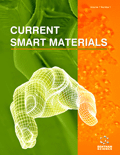Abstract
Background: Efficiency of the individual electrorheological materials is evaluated through their electrorheological characteristics. However, these characteristics are obtained using not only various geometries (plate-plate or concentric cylinders) but also completely different generation of an applied electric field.
Objective: Responsibility (comparison) of an electrorheological characterization by the individual measurements. Methods: This study summarizes and compares the results for one identical material (suspension of polyaniline powders mixed (10 wt%) in silicone oil) using both geometries housed in two commercial rotational rheometers: MCR 501 (Anton Paar Co.) and Gemini CVOR 150 (Malvern Instruments) in which the electric circuit loops are completed by a metal spring wire leaning against a central shaft and through an electrolyte filled in the circumferential gutter, respectively. Results: In the case of using the parallel-plate geometry, the data obtained by Physica MCR 501 provides higher values than those obtained by the Gemini CVOR 150. For concentric cylinders the data obtained by both devices are comparable. Conclusion: For both geometries and devices the functional behaviour of the studied rheological characteristics is in full correspondence.Keywords: Anton Paar MCR 501, electrocells, electrorheology, Gemini CVOR 150, rheological characteristics.
Graphical Abstract
 16
16


